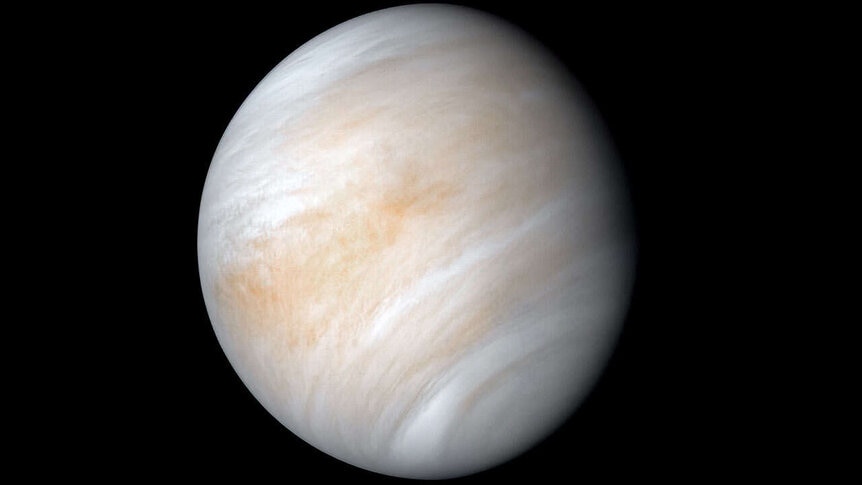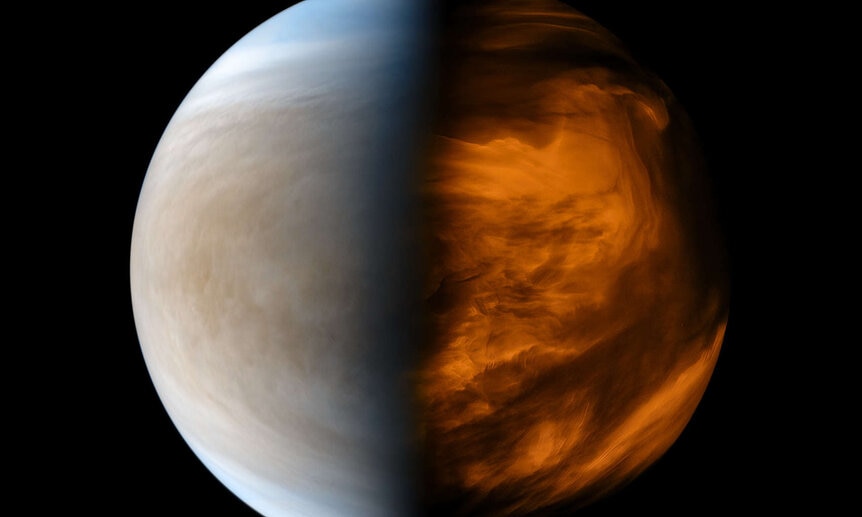Create a free profile to get unlimited access to exclusive videos, sweepstakes, and more!
Astronomers Detect Oxygen on Venus, But You Still Wouldn't Want to Go There
If you're hoping to visit Venus, don't hold your breath.
The mission planners behind The Ark (streaming now on Peacock) must have had their reasons for choosing Proxima centauri b as the next home for humanity, but it’s unlikely to be the most hospitable planet. Then again, even nearby worlds relatively similar to our own would be a total nightmare to live upon.
On paper, Venus should be a potential second home for our species. It’s roughly the same size and mass; it’s a rocky world with an atmosphere; and it’s inside the Sun’s habitable zone, though just barely. In the deep past, Venus might have been a lot more like the current Earth, with liquid oceans and a much more temperate climate. In the last few billion years though, Venus has transformed into something else entirely. Venus is a poster-world for the runaway greenhouse effect. With an atmosphere made up almost entirely of carbon dioxide, the planet is a thick, sweltering hell world, but there is a tiny glimmer of hope. Astronomers recently directly detected the presence of oxygen in the Venusian atmosphere for the first time.
A Thin Band of Oxygen Found on Venus
Venus’ dense atmosphere makes peering into its makeup exceedingly difficult, and scientists rely on infrared telescopes to see what’s going on beneath the cloud tops. Moreover, Earth’s atmosphere also creates a lot of infrared noise for ground-based telescopes. Fortunately, scientists have come up with some clever solutions.
RELATED: Scientists find evidence of active volcano on Venus in 30-year-old Magellan images
The recent observations, published in the journal Nature Communications, were taken using the Stratospheric Observatory for Infrared Astronomy. SOFIA, as it is affectionately called, is a flying observatory aboard a modified Boeing 747SP. The aircraft flies up to an altitude of 45,000 feet to get above as much of the dense parts of the atmosphere as possible, then it deploys an infrared telescope from its side.
From that vantage point, astronomers could peer into the many layers of the Venusian atmosphere, made up of two main bands of circulation. Nearer to the ground, below an altitude of about 70 kilometers, is a retrograde (rotating in the opposite direction of the planet’s rotation) super-rotational zonal flow of hurricane-speed winds. Higher up, about 120 kilometers above the surface, there is another band of winds flowing in the same direction as the planet’s rotation. Between them, astronomers have detected a thin strip of atomic oxygen – single oxygen atoms – roughly concentrated 100 kilometers above the surface.
Solar Chemistry Creates Oxygen in the Air of Venus
The oxygen is produced through photolysis, a process in which molecules are broken down through contact with light. At the atomic level, light itself is enough to decompose matter. On Venus, a year lasts about 225 Earth days but a Venusian day is even longer, roughly 243 Earth days. Consequently, when the Sun rises on Venus, it doesn’t set for a long time. On the day side of the planet, carbon dioxide and carbon monoxide are broken apart by sunlight, releasing atomic oxygen, not to be confused with molecular oxygen (O2) which we can breathe.
RELATED: A new battery technology could be the key to robots that can survive on hellish Venus
Because oxygen is produced directly by interaction with the Sun, we might have expected to find a distinct oxygen boundary between the day and night sides, but that’s not what astronomers found. Instead, atmospheric circulation spreads the oxygen around to the night side where it concentrates at the antisolar point. Once on the night side, atomic oxygen bounces into itself in a three-body reaction (when three particles bump into each other, causing two of them to join) and forms into molecular oxygen.
Having found oxygen, Venus becomes a tiny bit more hospitable, but don’t start packing your bags just yet. Oxygen concentrations are fleetingly low, nowhere near the 21% we enjoy here on Earth, and with surface temperatures of nearly 900 Fahrenheit, no amount of oxygen would let us breathe easily. Hopefully, the crew of The Ark have a better go of it.
Catch the complete first season of The Ark streaming now on Peacock.




































